| | Life Master Joel Johnson won the 2007 U.S. Senior Chess Championship and was a former award winning Editor of Chess Horizons. The following games are excerpts from Joel’s recently released book entitled, “Formation Attacks”. More information about the book can be obtained from the following website: http://www.lulu.com/product/paperback/formation-attacks/12922778.
White: FearNoEvil (2200)
Black: TheCrusher (2112)
[B07] Pirc Defense
ICC 5 0, 12/25/2003
1.e4 c6 2.d4 d6 3.Nc3 Nf6 4.Bd3 g6 5.Nge2 Bg7 6.f3 0-0 7.Be3 e5 8.Qd2 exd4 9.Nxd4 c5 10.Nde2 Nc6 11.h4 Nh5 12.g4 Nf6 13.h5 Ne8 14.Bh6 Ne5 15.Ng1 Qf6 16.Bxg7 Nxg7 17.Be2 gxh5 18.Nd5 Qd8 19.Qh6 f6 20.0-0-0 Be6 21.Nf4 Bf7 22.Nxh5 Bxh5 23.gxh5 Qe7 24.Nh3 Qf7 25.Rhg1 Kh8 26.Kb1 Rad8 (D)
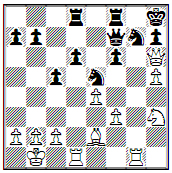
White has a solid advantage primarily because of the open g-file and Black’s King exposure. In addition, Black’s Queen is tied down defending the Knight on g7, which also happens to be checkmate. However, on the flip side, White has a Knight on h3 doing nothing, a Bishop on e2 tied down to defending the Pawn on f3, and the Rook on d1 could be more useful on the g-file. So, what’s my plan? Well, I decided that the best course of action was to improve the position of all those aforementioned pieces, and thus, increase the pressure on Black’s position. The easiest piece to fix is the White Bishop. Why? Well, the Black piece hindering the Bishop is the Knight on e5 and that Knight can be knocked out with 27. f4. But, before playing a move like 27. f4, we must make sure that we aren’t helping Black out by chasing his Knight to a better square. All the forward moves, Ng4, Nf3, Nd3, and Nc4 are protected by White’s Bishop. Don’t make the mistake thinking that the c4 square is protected, because it isn’t. The Black Knight also cannot go toward his King to help defend with either Ng6 or Nf7. Therefore, Black’s only real choices are either 27. ... Nc6 or 27. ... Nd7. After the Black Knight retreats, my Bishop is free to join in the attack. And, because the Black Queen is tied down defending the g7 square, we can get another free move attacking the Black Queen with 28. Bc4. I refer to this tactic as the Invisible Defender. Basically, the Bishop is protected by a stronger threat somewhere else on the board.
27.f4 Nc6 28.Bc4 Qe7
The next piece to improve is the Rook on d1 by doubling up the Rooks on the g-file. There are many moves that can accomplish this task, like, Rg2, Rg3, Rg4, Rg6, Rd2, and Rd3. I chose 29. Rg6 because it puts the most pressure on Black’s position by attacking the Black Pawn on f6 also.
29.Rg6 Rd7 30.Rdg1 Nd8
If you haven’t already noticed, Black is really tied up. He could only move the Knight on d8 and make some meaningless Pawn moves. Now, he wants to play 31. ... Nde6. I can prevent this move by playing 31. f5. Normally, I am reluctant to play a move like this because it opens up a permanent, big hole on e5, suitable for a Black Knight. But, I can see the conclusion of the game coming. More importantly, 31. f5 opens up the f4 square for my Knight, after which, I have enough pieces involved in the attack to finish Black off.
31.f5 a6 32.Nf4 b5 33.Bd5 c4 (D)
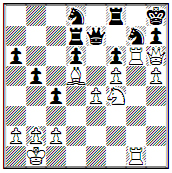
34.Rxg7 Qxg7 35.Ng6+ Qxg6 36.Qxf8+ 1-0
In our next game, white chooses to weaken his kingside Pawn formation, rather than lose a Pawn. Afterwards a fierce kingside attack by Black pays off just before White can promote one or more passed Pawns.
White: Champbuster (2425)
Black: FearNoEvil (2200)
[B02] Alekhine's Defense
ICC 5 0, 10/23/1999
1.e4 Nf6 2.e5 Nd5 3.Nf3 d6 4.c4 Nb6 5.exd6 cxd6 6.Nc3 g6 7.Be2 Bg7 8.0-0 0-0 9.a4 a5 10.d4 Nc6 11.Nb5 Bg4 12.Be3 Bxf3 13.gxf3
White intentionally chooses to destroy his kingside Pawn structure rather than give away the c4 Pawn. As a result, Black responds with a kingside attack.
13. ... e5 14.d5 Ne7 15.Qb3 Nbc8 16.Rac1 b6 17.f4 Nf5 18.fxe5 Bxe5 19.Kh1? (D)
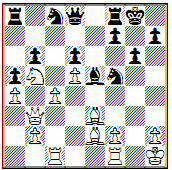
This seems like a reasonable move, however, White will be forced to play f4 to defend the checkmate on h2 which leaves the g3 square vulnerable. A better choice was Bd2.
19. ... Qh4 20.f4 Ng3+ 21.Kg2 Nxe2 22.fxe5 Qe4+ 23.Kf2 Nxc1 24.Rxc1 f5
My thoughts here are that I need some more help for my Queen. With each f-Pawn push, the Black passed Pawn becomes a bigger and bigger threat to White's King. In addition, the Black Rook on f8 also gets stronger with each f-Pawn move.
25.e6 f4 26.Bd4 f3 27.Qe3 Qh4+ 28.Kg1 f2+ 29.Kg2 Qg4+ 30.Qg3 (D)
Qe4+ 31.Kh3 Rf3
31. ... Rf5! with the idea of
32. ... Rh5+ is even stronger.
32.Bxf2 Rxg3+ 33.Bxg3
Black's attack has netted the White Queen, but White still has plenty of compensation.
33. ... g5
White's exposed King is still a problem and the attack continues.
34.Re1 g4+ 35.Kh4 Qf5 36.Nxd6 Nxd6 37.Bxd6
Losing the d-Pawn was offset by the Black Rook on a8 becoming liberated and a key factor in both the attack on the White King and the defense of the back rank against the two White connected passed Pawns. (D)
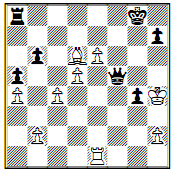
37. ... h6! 38.e7 Qf2+ 39.Bg3 Qf6+ 40.Kxg4 Kf7 41.d6 (D)
41. ... h5+ 42.Kh3
The best defense for handling the pesky White Passed Pawns is to strongly attack the exposed White King.
42. ... h4! 43.Bxh4
Recognizing how Black pitched his g- and h-Pawns to expose White's King directly to Black's Queen and Rook is important.
43. ... Qf3+ 44.Bg3 Rh8# 0-1 (D)
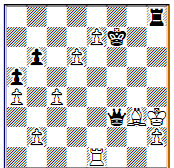
White: FearNoEvil (2200)
Black: Darkness (1864)
[C21] Center Game
ICC 3 0
Much like the last game, Black castles queenside and finds himself short of defenders. While, White develops his pieces very quickly and with the overwhelming firepower, the game is all over before Black can even complete his development.
1.e4 e5 2.d4 exd4 3.Bc4 Nc6 4.Nf3 d6 5.Nxd4 Bd7 6.Nc3 Qe7 7.0-0 0-0-0 (D)
8.Be3 Kb8 9.Nxc6+ Bxc6
Black is down to just one defender, the Bishop on c6.
10.Qd4 b6 11.a4 Bb7 12.a5 Nf6 13.axb6 cxb6
Strategically, Black is already busted, as the ratio of attackers to defenders is just too great on Black's queenside, a perfect situation for sacrifices like... (D)
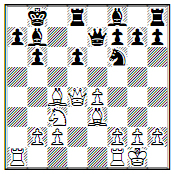
14.Rxa7!!
Positions like this one, where one side has a huge advantage in attackers, is where sacrifices happen. Another reason why this Rook sacrifice works is because a Replacement Attacker (the White Rook on f1) can easily and very quickly replace the lost Rook.
14. ... Kxa7 15.Nb5+ Kb8 16.Qxb6 d5 17.Ra1
The White Bishop is poison.17. … Qe6 18.Ra8+ Kxa8 19.Qa7# 1-0
White: Akiba Rubinstein
Black: G G Bartoszkiewicz
[C56] Two Knights Defense
Correspondence, 1897
A fascinating Invisible Defender game where White exploits his checkmating possibilities by working over an "overloaded Black Queen".
1.e4 e5 2.Nf3 Nc6 3.Bc4 Nf6 4.d4 exd4 5.0-0 Bc5 6.e5 d5 7.exf6 dxc4 8.Re1+ Kf8 9.Bg5 gxf6 10.Bh6+ Kg8 11.Nxd4 Bxd4 12.c3 Bf5 13.cxd4 Nxd4 14.Nc3 Bg6? (D)
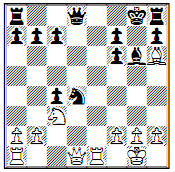
Black has so many weak dark squares to defend and the move Bg6 clearly illuminates the fact that Black is unaware of the dangers here.
15.Re8+!!
A brilliant method of exploiting Black's poor King position and all the weak dark squares around the Black King.
15. ... Qxe8 16.Qxd4 Qe5 (D)
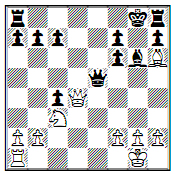
17.Nd5!! 1-0
The Black Queen cannot protect all the checkmating squares. White checkmates Black after either: 17. ... Qxd4 18. Ne7#; or 17. ... Qxd5 18. Qxf6 followed by Qg7#.
This book contains many beautiful attacking games by the great Rashid Nezhmetdinov. In America, everybody knows about Mikhail Tal. But, if you ask them to name the ten greatest attacking chess players of all-time, I feel very sure that Nezhmetdinov would be left off many people's lists. As, he was, in my opinion, the greatest attacking chess player that nobody in America has heard of. Hopefully, this book will will open quite a few eyes.
Just when you think you know how the game will end, you encounter a surprising twist.
White: Rashid Nezhmetdinov
Black: P Ermolin
[B71] Sicilian, Dragon, Levenfish
Kazan Championships,
Kazan, Russia, 1946
1.e4 c5 2.Nf3 d6 3.d4 cxd4 4.Nxd4 Nf6 5.Nc3 g6 6.f4 Bg7 (D)
7.e5 dxe5 8.fxe5 Nd5 9.Bb5+
Here is that pesky check along the a4-e8 diagonal again.
9. ... Kf8
Any other move loses the Black Knight on d5.
10.0-0 Bxe5?
More Pawn grabbing – very unwise.
11.Bh6+ Kg8 12.Nxd5 Qxd5 (D)
On the surface, it would appear that Black is holding everything together, but this is exactly the kind of position that attackers just love. A wide open position with loads of options against an under-developed opponent.
13.Nf5!! Qc5+
Black gets checkmated after 13. Qxd1 Nxe7#.
14.Be3 Qc7 15.Nh6+ 1-0
It's checkmate as either of Black's responses 15. ... Kg7 or 15. ... Kf8 are met with 16. Rxf7#.
And Black gets checkmated after 28. ... Kxh8 29. Rxf8+ Ng8 30. Be5+ Qg7 31. hxg7#.
|